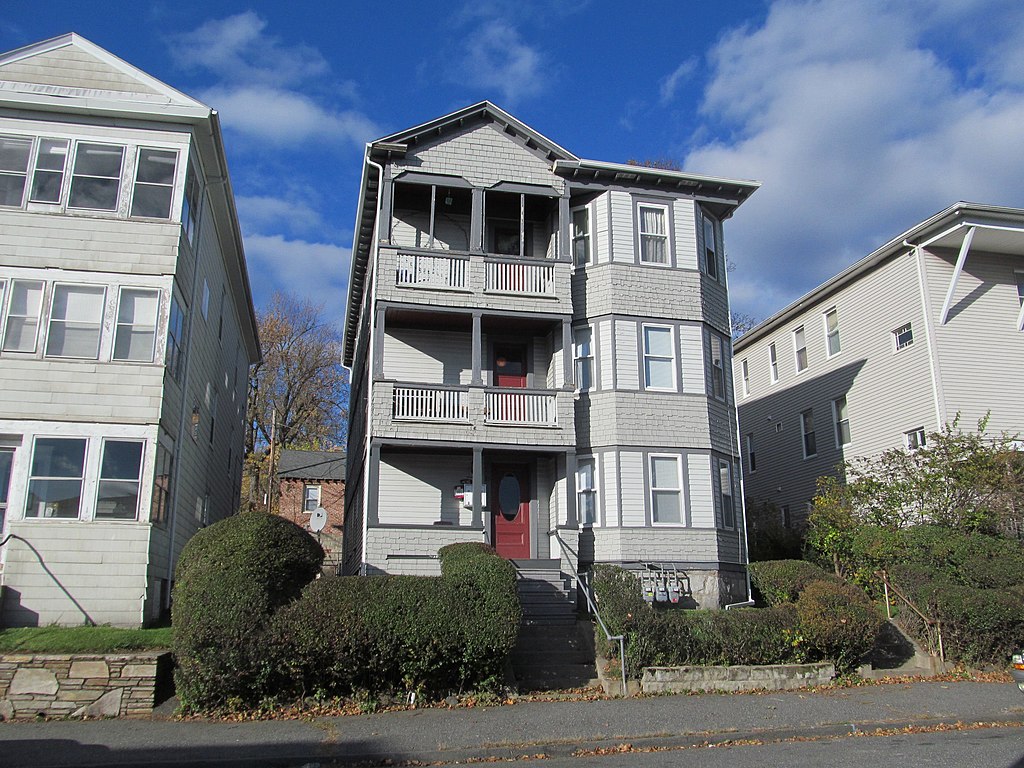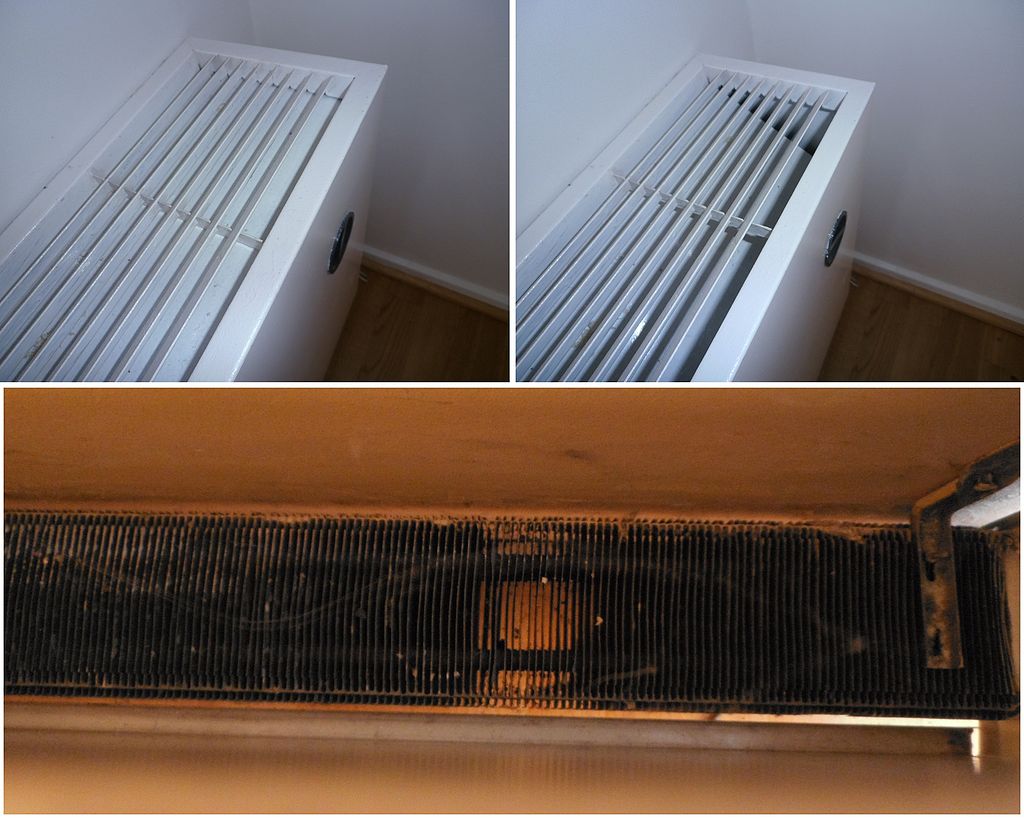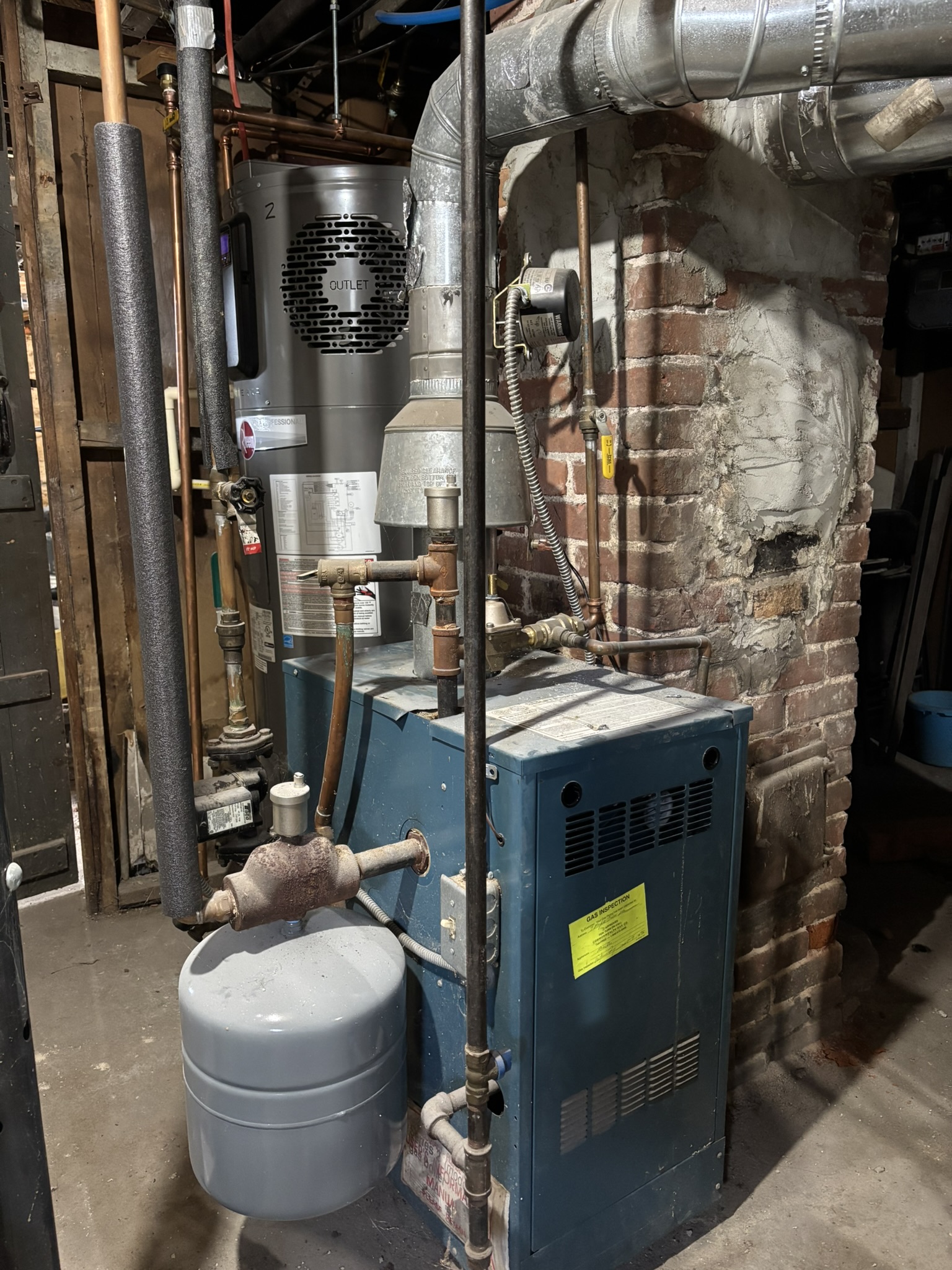Incentives Needed for Air-to-Water Heat Pump Conversions in Multifamilies: An Open letter to the Program Administrators of Mass Save
| . Posted in News - 0 Comments
By Eric Weld, MassLandlords, Inc.
We applaud the work of Mass Save in recent years to help nearly 100,000 Massachusetts residents, as well as rental property and business owners, convert their buildings away from fossil fuel energy to electric heat pumps. We have, in fact, participated in devising policy used by Mass Save through our state seat on the Equity Working Group (EWG) of the Department of Energy Resource’s (DOER) Energy Efficiency Advisory Council, which was tasked with developing the Mass Save three-year plan for 2025-2027. We fully and publicly support that plan.

Many older triple-deckers, like these multifamilies in Worcester, use forced hot water heating systems, which radiate heat through baseboard or steel radiators or under-floor pipes, fueled by oil, gas or propane. Massachusetts hosts tens of thousands of these buildings. We propose a Mass Save pilot program that incentivizes owners of these types of properties to convert to electric air-to-water heat pumps. Image: cc by-sa John Phelan Wikimedia commons
Unfortunately, the progress made so far is not nearly enough to reach our state’s carbon neutral goals. Rental property owners, especially landlords of older buildings with forced hot water heating, are consistently lagging single-family owners in converting to electric energy systems, for several reasons.
We would like to propose that Mass Save incentivize multifamily owners with hydronic heating to replace their gas-, oil- or propane-burning boilers with air-to-water heat pumps, allowing them to convert to electric relatively cheaply while leaving their hydronic systems in place.
This proposal would preferably be introduced within the current three-year plan, but could also work as an added feature of the three-year plan beginning in 2028.
We explain our proposal in detail below.

Forced hot water baseboards like this unit produce high-quality, consistent heat by radiating warm air through a tightly aligned series of aluminum fins, as shown in the bottom frame. The top two frames show the baseboard radiator’s cover with top vent closed and open. A drop-in air-to-water heat pump would allow owners of these types of systems to keep them in place in their homes and rentals. Image: cc by-sa Tomakkermans Wikimedia commons
Air-to-Air vs. Air-to-Water Heat Pumps for Multifamilies
Massachusetts hosts tens of thousands of multifamily residential buildings, many of them built a century or more ago. Boston alone has 15,000 triple-deckers; there are another 4,000 in Worcester. Among all types of multifamily buildings, including condos, there are more than 60,000 in our state, with more than 600,000 dwellings, according to the 2022 Census of Multifamily Buildings published by the Energy Efficiency Advisory Council.
A large share of old multifamily buildings use forced hot water systems to heat their interior spaces, powered by fossil fuel combustion. Warm water is distributed through baseboards or steel radiators. A few have installed subfloor pipe networksDrop-in replacement of an air-to-water heat pump for a boiler is a relatively simple job.
Alternatively, replacing these hydronic energy systems with air-to-air heat pumps, as incentivized through Mass Save, is often not cost-effective or the most efficient choice, for a few reasons. These old buildings typically have lots of walls and unusual room configurations with angles that obstruct air flow. They often have odd extensions, enclosed porches and breezeways equipped with baseboards supplying dedicated heat for a small space. Most of them also lack ductwork or the wall space to install ducts.
Because of these idiosyncrasies, which many find charming, heating interiors of these buildings with ductless mini-split air handlers is not an ideal match, especially when water-based systems are already in place and only in need of a drop-in replacement heat pump. One rental unit in some buildings might require eight or 10 mini-split heads with two exterior condensers, at high cost to Mass Save.
Worse, performance contractors don’t advise installing mini-split heads in the bathroom, where heat is vital to prevent frozen pipes. Instead, they recommend electric resistance, a less efficient system and an added grid stressor.
Further complicating air-to-air heat pump installation is the need to enter tenants’ rental units, or even relocate them temporarily, at additional steep cost. Installing a drop-in replacement air-to-water heat pump in the cellar of a multifamily would avoid that expense and inconvenience.
Finally, there’s the quality of the heat. Hydronic systems produce high-quality, consistent, more radiant heat in comparison to mini-split handlers. Many multifamily owners would like to convert to electric heat. They want to eliminate fossil fuel combustion, improve safety in their properties and free their businesses from volatile fuel prices, all while retaining their hydronic systems.
All these objectives are attainable, but not cost-efficient for rental property owners within the current incentivization structure. We see this conundrum as a looming barrier to achieving our state’s carbon reduction goals.

This old boiler (blue) is similar to many that are ideal candidates for air-to-water heat pump replacement. The copper forced hot water lines are at left of frame and insulated. The boiler, gas line (center of frame) and combustion exhaust can all be removed. A refrigerant line set can be run from this location to an exterior condenser a few feet away. The heat pump can be placed where the boiler and exhaust once stood. There would be no need to enter any of the rental units above. In the background, a heat pump water heater stands in the place of a gas water heater. CC BY-SA 4.0 MassLandlords
Our Proposal: Support Air-to-Water Heat Pumps for Interior Heating
The above reasons inform our proposal for Mass Save to offer a carve-out efficiency standard to permit air-to-water heat pump conversions for owners of multifamily buildings with hydronic systems.
As part of our proposal, we also suggest adjustments to current efficiency thresholds for qualifying for rebates, tax breaks and interest-free heat loans through Mass Save. Coefficient of Performance (COP) levels currently set by Energy Star and Mass Save that determine eligibility for financial incentives will likely not pertain to many air-to-water heat pump system purchases.
We realize that many hydronic heating systems require an energy source that can heat up supply water to a very high temperature, around 180 degrees Fahrenheit, in order to achieve convective air flow from radiators. The high supply water temperature is necessary to generate interior heat at desired temperatures during cold outside weather.
A few heat pumps on the market are capable of producing high supply water temperatures, but because of their high output temperature, they are not as efficient as air-to-air heat pumps that can operate at lower temperatures in order to simply create warm air flow through a space. These heat pumps’ COP ratings may run below a 3, rendering them ineligible for Mass Save incentives.
We suggest an adjustment, or carve out efficiency standard, for high-temperature air-to-water heat pumps in order to incentivize these conversions at low cost.
More Production for Equal Budget
Air-to-water heat pumps are commonly used through Europe and Japan with low-temperature output. Sanden and Nordic are two brands that could be installed here but would likely require modifications to baseboards to work with lower supply water temperatures. This kind of in-unit expense is what we propose to avoid entirely.
There are two market-ready, high temperature choices in the U.S. today.
We have written before about two products available to American property owners: Arctic Heat Pump’s Extreme High Temperature model, and the Daikin Altherma model.
Both these heat pumps can produce supply water of temperatures near 180 degrees Fahrenheit, high enough to achieve effective radiant heat through forced hot water baseboards, radiators and under-floor grids.
The Arctic Extreme model uses R-410A refrigerant, a gas with high Global Warming Potential, which is not legal for commercial use in the U.S. (residential HVAC use of R-410A remains legal for the moment). Arctic has stated that even in the event of a phaseout of R-410A in the U.S., their models can easily convert to accommodate new refrigerants.
MassLandlords members have experience with Daikin products, having worked with representative Dan Smith in 2023 on a successful pilot installation of its Altherma heat pump in a member’s six-family property. Daikin products use R-32 refrigerant, which is widely used in U.S. products and not scheduled for phaseout.
Our pilot proposal would suggest Arctic and Daikin as first-stop collaborators that have had air-to-water high temperature heat pumps on the market for several years.
Working with brands like Arctic and Daikin, a statewide Mass Save air-to-water carve-out efficiency standard could substantially increase production and the rate of installs, thereby lowering per-install costs. In fact, for Mass Save, the cost of supporting air-to-water heat pumps for multifamilies would be much lower than providing incentives for air-to-air systems for these buildings. Heating apparatuses are already in place, so expenses would only include the installation of the heat pump systems, cutting the need for interior air handlers or minisplits.
Lower installation costs and higher volume, coupled with DOER winter rates, could have the welcome effect of holding energy bills constant for property owners switching to air-to-water, even with lower efficiency heat pumps in comparison with air-to-air. Multifamily owners will help their bottom line by freeing their businesses from the unpredictability and instability of fossil fuel prices.
These conditions could set the stage for more production for the same budget, and more greenhouse gas reductions for the same budget, by incentivizing air-to-water heat pump conversions for multifamily owners with hydronics. A pilot will tell us for sure.
Cooling Still Needed
We also want to acknowledge that our proposal, while much less costly than switching from hydronic systems to air source heat pumps, will not provide multifamily owners with cooling. While it’s possible to cool using baseboard forced hot water pipes, a costly update of the pipes would likely be needed to insulate them and add feedback loops to control the water temperature. Without such an update, condensation and mold will always be a threat whenever the pipe temperature falls below the dewpoint. In this regard, air-to-water loses out to air-to-air, which does provide cooling.
But using one dual system heat pump for both heating and cooling can be problematic. To install air-to-air heat pump systems for both heating and cooling a triple decker interior requires very high-powered products, in order to provide enough heat for the very cold outside temperatures of mid-winter. When it comes time to cool in summer, those high-powered systems are overpowered for cooling. The high-powered cooling cycle tends to overwhelm the inside space with humidity, resulting in condensation, the potential for mold and requiring regular heat pump cleaning. This is the so-called “short-cycling” problem and is well documented.
For cooling homes with hydronic systems, it makes more sense to use window air conditioners or invest in air source heat pumps strictly for cooling.
Also, having separate heat pumps for interior cooling would require fewer air handlers or minisplits inside than a dual heating-cooling system. And some heat pumps designed only for cooling tend to be cheaper than those intended for both heating and cooling.
For many multifamilies, it’s more efficient to have separate systems for heating and cooling, whatever the type of system. The goal is rapid decarbonization – not air conditioning – and drop in air-to-water offers a possible step-change in cost per install.
Owners just need adequate incentive policies to make the switch.
Also Needed: Hot Water Heat Pump Incentivization
It’s also important to acknowledge that our proposal pertains to air-to-water heat pumps for interior space conditioning (heating) only, as distinct from heat pump water heating. Water heating is an equally important issue, and one that too often takes a back seat to ongoing campaigns to convert to heat pumps for interior space conditioning.
It makes sense to prioritize replacement of space heating fossil fuel boilers. In general, interior heating and cooling consumes nearly twice as much energy as water heating needs, for showers, faucets and laundry.
That said, a significant number of homes and businesses in Massachusetts (and nationwide) continue to heat water using gas, oil or propane. Incentivizing these property owners to convert to heat pump water heaters will soon need to take higher priority in order to meet the state’s decarbonization goals. And, like an air-to-water drop-in for space heating, heat pump water heaters are, in many instances, drop-in replacements as well.
Incentive Policy Shift Needed for Conversion Goals
Between 2020 and 2025, Mass Save has admirably implemented an infrastructure with incentives to assist tens of thousands of customers in converting away from fossil fuels. Now, in the five years leading to 2030, the state’s goals are set significantly higher: to convert 500,000 additional households to heat pumps. In order to meet conversion goals, several times more households will have to convert to electric power in the next five years.
Among those, tens of thousands are multifamily owners, many of them landlords of rentals in older buildings with hydronic heating, difficult to convert to air-to-air heat pumps. A lag among these property owners, who lack cost-effective incentives, could jeopardize the state’s decarbonization goals.
The gap in conversions for multifamilies will certainly be exacerbated by recent cuts to the Mass Save electric conversion budget by the Department of Public Utilities in response to customer complaints of high heating costs. The DPU cuts resulted in a $500 million reduction for Mass Save, much of which was slated to support multifamily owners in 21 selected communities convert to heat pumps.
The importance of our proposal is multiplied in the wake of the recent Mass Save budget cut.
Most multifamily owners want to convert away from expensive, unpredictable and polluting fossil fuel heating for their rentals. Current incentives for air-to-air are likely sufficient, but at what cost to the public? Air-to-water might get the job done for a fraction of the planned cost.
Frequently Asked Questions (FAQs)
Didn't this article used to mention solar?
Yes, we previously incorrectly stated that solar would offset grid stress. We've removed that because it was inaccurate (solar offsets total energy but not peak load). The larger message about the need for an efficiency carve-out for air-to-water stands.
What do you mean Mass Save requires a COP of 3?
Mass Save does not require a COP of 3 for air-to-water. We realized after publication that this was so underexplained as to be misleading. This FAQ was added 2025 May 6 to explain the problem in three detailed steps:
1. The "air source" minimums are all above 3, and these are in practice applied to air-to-water.
There are two touchpoints where a rebate or incentive needs to be approved: once at program intake and again post-install. Mass Save subcontractors have in the past approved at intake and then, when reviewing the COP, they have denied the project post-install. This has left actual owners holding the bill for an air-to-air project.
Many program documents talk simply about "air source" without regard to the full energy transfer (air-to-air or air-to-water). To the extent the program documents or guidelines talk about "air source," Mass Save program documents have required COPs of at least 3 at 47°F. This is confusing, because these requirements only apply to "air-to-air." Plus, Mass Save now more commonly specifies COP minimums at 5°F, which are less than 3. But the old information and "3s" are everywhere online and the number that most commonly came to mind when we have asked installers. The confusion coupled with the risk of rejection is enough to stop installers and owners from pursuing air-to-water in the first place.
The confusion is not easy to clear up. To give one example, we wrote the Mass Save program directly on May 29, 2024 about minimum COPs for air-to-air. The official response came back confused. A VP of PR & Crisis Communications inaccurately gave the air-to-water COP not the air-to-air COP. If the official response is confused, imagine what project approval looks like.
Solution 1: Mass Save program documents could never say "air source." We could talk in terms of "air-to-air" or "air-to-water" and eschew "air source" as too vague.
2. The carve-out for air-to-water COPs seems to apply to low temperature only.
At time of writing, the Mass Save Heat Pump Qualified Product List read as follows:
Air to Water Heat Pumps (Residential Only)
Criteria is as follows:
•Minimum COP of 1.7 while delivering 110°F supply water at an outside temperature of 5°F.
•Fully displacing existing hydronic heating
•Maximum 6 tons nominal capacity
This language implies air to water heat pumps should not be paid for by Mass Save if they do not provide output of 110°F on the nose. Thermodynamic efficiency goes down as output temperature increases relative to ambient. It stands to reason that the restriction on output temperature is intended to be a deliberate prohibition on high temperature output.
Solution 2: We could rewrite this guidance. It could say air-to-water is covered with a "Minimum COP of X while delivering at least 110°F supply water at an outside temperature of 5°F." Or better yet, we would need a different COP (perhaps lower still) for 165°F output at 5°F.
As we've said throughout the article, the goal is rapid reduction in emissions, not efficiency. Even with a COP of 1 at 5°F we've achieved a 100% emissions reduction. The 5°F COP minimum is a corner case that should not attract undue negative attention; the average COP is much higher. In Worcester in 2023, the average day was 50.7°F.
3. Mass Save requires Energy Star 6.1, which doesn't recognize air-to-water.
Federally, the ENERGY STAR® Program Requirements Product Specification for Central Air Conditioner and Heat Pump Equipment versions 6.1 and 6.2 do not recognize air-to-water. Both read, "In 2019 and 2020, EPA’s ENERGY STAR Emerging Technologies program recognized highly efficient air to water heat pumps that have acceptable cold climate performance. As this technology gains a foothold in the US, EPA anticipates it will eventually make sense to include this type of product in the scope of the CAC/HP specification."
Mass Save program documentation including the three-year plan warrant to the Department of Public Utilities that all air source products will be Energy Star 6.1, and then it's only by a kind of afterthought additional line that implies air-to-water will be handled differently. In the version of the plan published in early 2025, this confusion is on page 136, and the air-to-water exemption appears only for Tier 3 embodied carbon devices.
Solution 3: Program documents should explicitly state that air-to-water does not have to be Energy Star. Again, the goal is a rapid reduction in emissions, not efficiency.
It seems clear that there is will and legal authority to allow air-to-water at the lower COPs. The program documentation remains vague and the distributed workforce undertrained. At time of writing, we were not aware of anyone having received a Mass Save rebate for a high temperature air-to-water boiler replacement. Have you received one? Email us at hello@masslandlords.net.




